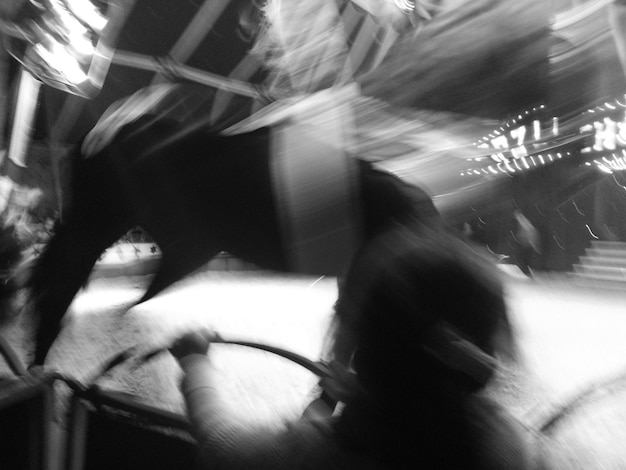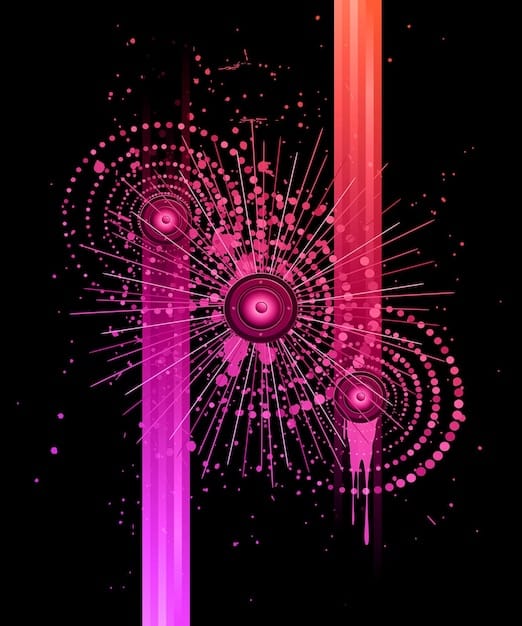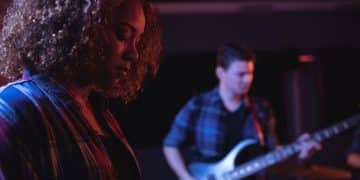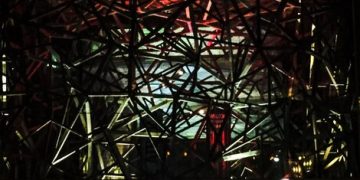US Underground Dance Music: 4 Subgenres You Need to Know in 2025

US Underground Dance Music is a vibrant and ever-evolving scene, and in 2025, several subgenres are poised to make a significant impact, from the industrial sounds of techno’s fringes to the hypnotic rhythms of microhouse, offering a diverse range of sounds for adventurous listeners.
Dive into the pulsating heart of American nightlife as we explore the **US Underground Dance Music: 4 Subgenres You Need to Know in 2025**. These sounds aren’t just music; they’re a culture, a movement, a hidden world pulsing beneath the mainstream.
Exploring the Electric Underground: A 2025 Dance Music Preview
The US underground dance music scene is a melting pot of creativity, constantly birthing new sounds and pushing boundaries. In 2025, a handful of subgenres are set to explode, captivating audiences with their innovative approaches and raw energy. These aren’t your typical chart-toppers; these are the tracks that ignite underground clubs and inspire dedicated followers.
Let’s uncover the four subgenres that are set to define the US underground dance music landscape in 2025, exploring their origins, key characteristics, and the artists who are leading the charge.
1. The Resurgence of Industrial Techno
Industrial techno is making a serious comeback, blending the relentless beats of techno with the gritty textures and experimental spirit of industrial music. Expect a soundscape that is both dark and driving, perfect for late-night warehouses and abandoned factories.
This isn’t your run-of-the-mill dance music; it’s a sonic assault designed to push boundaries and challenge listeners.
Key characteristics of Industrial Techno
Industrial techno is defined by its aggressive sound, incorporating harsh noise elements and distorted rhythms to create a raw and intense listening experience.
- Relentless, driving beats
- Distorted and abrasive sounds
- Dark and atmospheric textures
- Experimental and unconventional structures
Artists like SARIN and Paula Temple are at the forefront of this movement, crafting tracks that are both physically demanding and mentally stimulating.

2. The Hypnotic World of Microhouse
On the opposite end of the spectrum, microhouse offers a more minimalistic and subtle approach to dance music. It’s all about the groove, utilizing intricate rhythms and minimal melodies to create a hypnotic and immersive experience.
Think of it as a sonic tapestry woven from the tiniest of sounds, creating a captivating and engaging listening experience.
What defines Microhouse?
Microhouse is characterized by its stripped-down sound, focusing on intricate rhythms and subtle sound design to create a mesmerizing atmosphere.
- Minimalistic arrangements
- Intricate and evolving rhythyms
- Hypnotic and immersive soundscapes
- Focus on subtle details and textures
Ricardo Villalobos and Akufen are considered pioneers of microhouse, inspiring a new generation of artists who are continuing to push the boundaries of the genre. Rhadoo is another artist who is making amazing microhouse music.
3. The Evolution of Footwork into Hyperfunk
Originating in Chicago, footwork has evolved into a faster and more complex genre called Hyperfunk. This is a rapid-fire, rhythmically intense sound characterized by incredibly fast tempos and complicated syncopation.
It’s a genre that demands attention, challenging both dancers and listeners to keep up with its relentless pace.
Hyperfunk: Key Aspects
Hyperfunk distinguishes itself with its extreme tempos and its complex syncopations, presenting a significant challenge to both dancers and listeners.
- Extremely high tempos (160 BPM and above)
- Complex and syncopated rhythms
- Chopped samples and vocal snippets
- Emphasis on rhythmic complexity
Artists such as DJ Earl and RP Boo are integral figures in the Hyperfunk evolution, driving the genre forward with relentless innovation.
4. The Eclectic Fusion of Experimental Bass
Experimental bass music is difficult to define, being more of a wide field that fuses elements from several genres such as dubstep, drum and bass, and IDM, resulting in a sound profile that is unconventional and adventurous.
By embracing experimental ideas and pushing the envelope, this genre provides musicians with an open canvas to create music that defies common expectations and is immensely fascinating.

What Comprises Experimental Bass Music?
Experimental bass explores the synthesis of various genres, using complex sound design and inventive arrangements to challenge the established norms of bass music.
- Blending diverse genres, including dubstep, drum and bass, and IDM.
- Complex and inventive sound design
- Non-traditional structures and arrangements
- An environment encouraging artistic expression
Flying Lotus and Bassnectar have made essential contributions to the genre by continuously experimenting and impacting how electronic music is produced.
Why These Subgenres Matter
In 2025, these subgenres have significance that goes beyond simply hearing pleasure. They are essential to upholding innovation, diversity, and cultural expression in the US underground dance music scene. They give a stage for artists who break barriers, question accepted standards, and produce music that personally connects with listeners.
As they continue to grow and evolve, these subgenres will influence the trajectory of dance music, encouraging both the underground and mainstream settings to try new things.
How to Dive Deeper into the Underground
Discovering these subgenres involves more than just browsing streaming services; it requires active participation within the underground music community. Go to neighborhood events, support local artists, and network with other music lovers to fully appreciate the scene.
In addition, supporting the artists and promoters will help these subgenres flourish, guaranteeing their continued existence and originality in the dance music world.
| Key Aspect | Brief Description |
|---|---|
| 🎶 Industrial Techno | Aggressive sound, blends techno with gritty industrial textures. |
| 🎧 Microhouse | Minimalistic, focusing on intricate rhythms and hypnotic grooves. |
| 👟 Hyperfunk | Evolved from Footwork, features extremely fast tempos. |
| 🎛️ Experimental Bass | Fusion of dubstep, drum and bass, and IDM, pushing sound boundaries. |
FAQ
▼
Industrial Techno stands out due to its aggressive sound, combining harsh noise and distorted rhythms with the fundamental elements of techno. It’s a darker, more intense genre that challenges listeners with its boundary-pushing approach.
▼
Microhouse achieves its hypnotic effect through minimalistic arrangements and intricate rhythms. Each sound is carefully chosen and subtly manipulated to create a mesmerizing and immersive atmosphere that captivates the listener.
▼
The key characteristics of Hyperfunk include extremely high tempos, complex and syncopated rhythms, and the use of chopped samples and vocal snippets. These elements create a high-energy, rhythmically challenging experience for dancers and listeners alike.
▼
Experimental Bass is influenced by a variety of genres, including dubstep, drum and bass, and IDM. This fusion allows artists to explore unconventional sound designs and arrangements, pushing the boundaries of traditional bass music.
▼
Supporting underground music is essential for fostering innovation, diversity, and cultural expression. It provides a platform for artists who challenge norms and create music that resonates deeply with listeners, ensuring the scene’s continued vitality.
Conclusion
As we look ahead to 2025, these four subgenres—Industrial Techno, Microhouse, Hyperfunk, and Experimental Bass—are poised to dominate the US underground dance music scene. By embracing the unconventional, supporting local artists, and diving deep into the community, you can experience the exhilarating sounds and cultures that drive this exciting movement.




